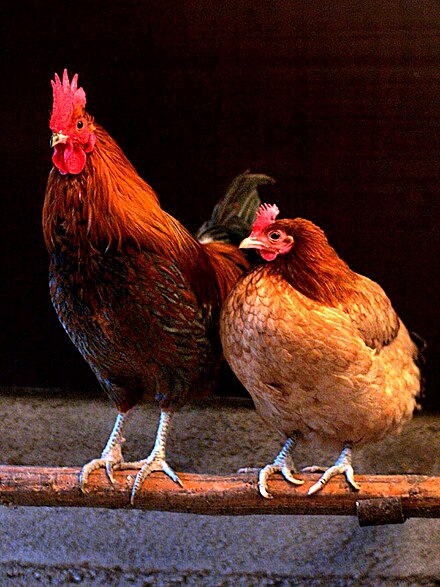Domestic chicken (scientific name: Gallus gallus domesticus) is a poultry domesticated from the red jungle fowl and is one of the most common domestic animals in the world. Due to long-term selective breeding, today's domestic chickens have great diversity in body shape, feather color, egg-laying ability, etc. Domestic chickens play a very important role in human life, both as a source of food and as an economic activity in poultry farming.

(left) rooster and hen (right)
Basic Features
Body shape and appearance: Domestic chickens come in a variety of sizes and feather colors, ranging from small guinea fowl to large broiler chickens. Feather colors can be white, black, brown, yellow, etc.
Lifespan: The average lifespan of domestic chickens is about 5 to 10 years, but some domestic chickens can live more than 10 years under good conditions.
Gender Differences: Adult roosters (males) are usually larger than hens (females), have a distinctive crowing sound, longer tail feathers, and brightly colored earlobes and comb (the protruding part of the head); while hens are smaller and usually No chirping.
Food habits: Domestic chickens are omnivores and their natural food includes seeds, insects, small animals and even some plant parts. Chickens raised in captivity mainly feed on corn, barley, wheat and specially prepared food pellets.
Social behavior: In the wild, domestic chickens will form groups consisting of multiple hens and one or more roosters. In this kind of social structure, there is often a strict hierarchy, called the "pecking order".
Roosting and activities: Domestic chickens are active during the day and look for safe places to roost at night. They are not adapted to flight, but can perform short-distance flight, usually to escape predators or find habitat.
Egg laying: Domestic chickens reproduce by laying eggs. Hens can lay hundreds of eggs per year, depending on the breed and breeding conditions.
Incubation: The incubation process takes approximately 21 days. Under natural conditions, hens will incubate eggs until chicks hatch; in a breeding environment, an incubator may be used.
Breed improvement: Through selective breeding, humans have developed many domestic chicken breeds suitable for producing meat and eggs.
Breeding Styles: There are many ways of raising chickens, from free-range small-scale family farms to intensive large-scale chicken farms.
Although the domestic chicken is an extremely successful domesticated species, some subspecies of its wild cousin, the red junglefowl, may face threats to their survival in the wild, such as habitat loss and hunting pressure. On the other hand, there are also controversies regarding animal welfare in the domestic chicken breeding industry. For example, cage or intensive breeding may lead to a decrease in the quality of life of chickens.
Food sources: Domestic chickens provide an important source of food for humans, including chicken meat and eggs.
Cultural significance: In many cultures, the chicken has symbolic meaning. For example, in Chinese culture it is a symbol of courage and protection.
Economic Activities: Chicken farming is an important part of global agriculture and involves huge economic benefits.
As poultry, chickens have always been extremely important livestock in human history. They not only provide nutrition to humans, but are also an important object of agricultural production and biodiversity research.
animal tags:
We created this article in conjunction with AI technology, then made sure it was fact-checked and edited by a Animals Top editor.